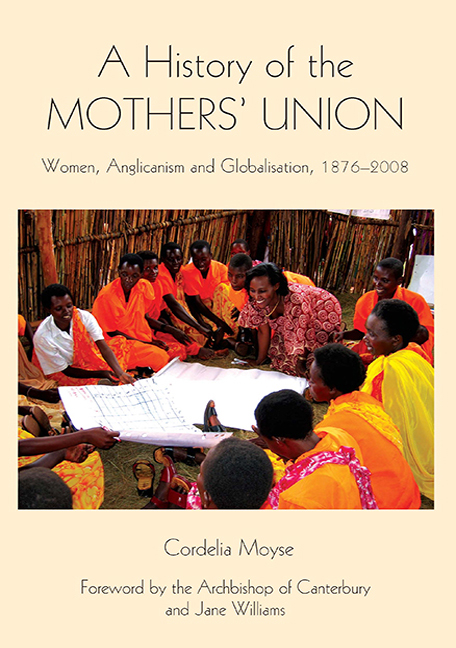Book contents
- Frontmatter
- Contents
- Dedication
- List of Illustrations
- Foreword by the Archbishop of Canterbury and Jane Williams
- Acknowledgements
- Abbreviations
- Introduction
- Part I 1876–1909
- 1 Launching the Mothers’ Union
- 2 Identity and Spirituality
- 3 Marriage and Family Life
- 4 Membership and Worldwide Work
- Part II 1910–1944
- Part III 1945–1974
- Part IV 1975–2008
- Conclusion
- Appendix 1 Text of early membership cards
- Appendix 2 Development of the Mothers' Union prayer
- Appendix 3 Midday prayers (original)
- Appendix 4 Development of the objects
- Appendix 5 Biographical notes on central and worldwide presidents
- Bibliography
- Index
- Miscellaneous Endmatter
3 - Marriage and Family Life
from Part I - 1876–1909
Published online by Cambridge University Press: 29 April 2017
- Frontmatter
- Contents
- Dedication
- List of Illustrations
- Foreword by the Archbishop of Canterbury and Jane Williams
- Acknowledgements
- Abbreviations
- Introduction
- Part I 1876–1909
- 1 Launching the Mothers’ Union
- 2 Identity and Spirituality
- 3 Marriage and Family Life
- 4 Membership and Worldwide Work
- Part II 1910–1944
- Part III 1945–1974
- Part IV 1975–2008
- Conclusion
- Appendix 1 Text of early membership cards
- Appendix 2 Development of the Mothers' Union prayer
- Appendix 3 Midday prayers (original)
- Appendix 4 Development of the objects
- Appendix 5 Biographical notes on central and worldwide presidents
- Bibliography
- Index
- Miscellaneous Endmatter
Summary
To uphold the sanctity of marriage and to awaken in all mothers a sense of their great responsibility in the training of their boys and girls – the fathers and mothers of England.
(First and second objects, 1896)On joining the Mothers’ Union members did not simply sign up to attend meetings but made a personal commitment to live out their pledge to strengthen marriage and family life as expressed in the first two objects. The organisation in the context of collective prayer and fellowship provided practical suggestions and advice as to how each member could faithfully carry out her Christian vocation. The focus was on women imparting spiritual and moral values within the home through example and influence rooted in faithful prayer. Any improvement in family life came about through the actions of, and was experienced by, the individual member within her home or in her neighbourhood.
Yet as the 1890s progressed the landscape that had informed the original vision of the MU was brought into question. The organisation was faced with the growing politicisation of what could be seen as religious or moral issues and the formulation of public policies that were encroaching in new ways on family life. In the wake of this, the leadership felt branch meetings with improving articles and addresses were not sufficient tools in themselves to enable members to live out their vocation. The efforts and beliefs of individuals could be rendered null and void by changes in public policy. Womanly influence needed to be applied collectively and strategically. By the end of the 1890s the MU had increasing organisational capacity, and a membership of over 150,000 gave it for the first time the capability of exercising influence as a mass movement on a large scale.
It was finally drawn into collective public action when legislation was proposed which seemed a direct assault on its first two objects. Like many Christian reformers, as well as campaigners for women's rights, from whom the MU was keen to distance itself, the organisation considered the issues that were provoking political campaigning to be religious and moral rather than political. Faced with the undermining of family life through the curtailing of parental responsibility and the facilitating of divorce, contained in proposals for educational and matrimonial law reform, the MU began to walk the corridors of political power.
- Type
- Chapter
- Information
- A History of the Mothers' UnionWomen, Anglicanism and Globalisation, 1876–2008, pp. 62 - 77Publisher: Boydell & BrewerPrint publication year: 2009



